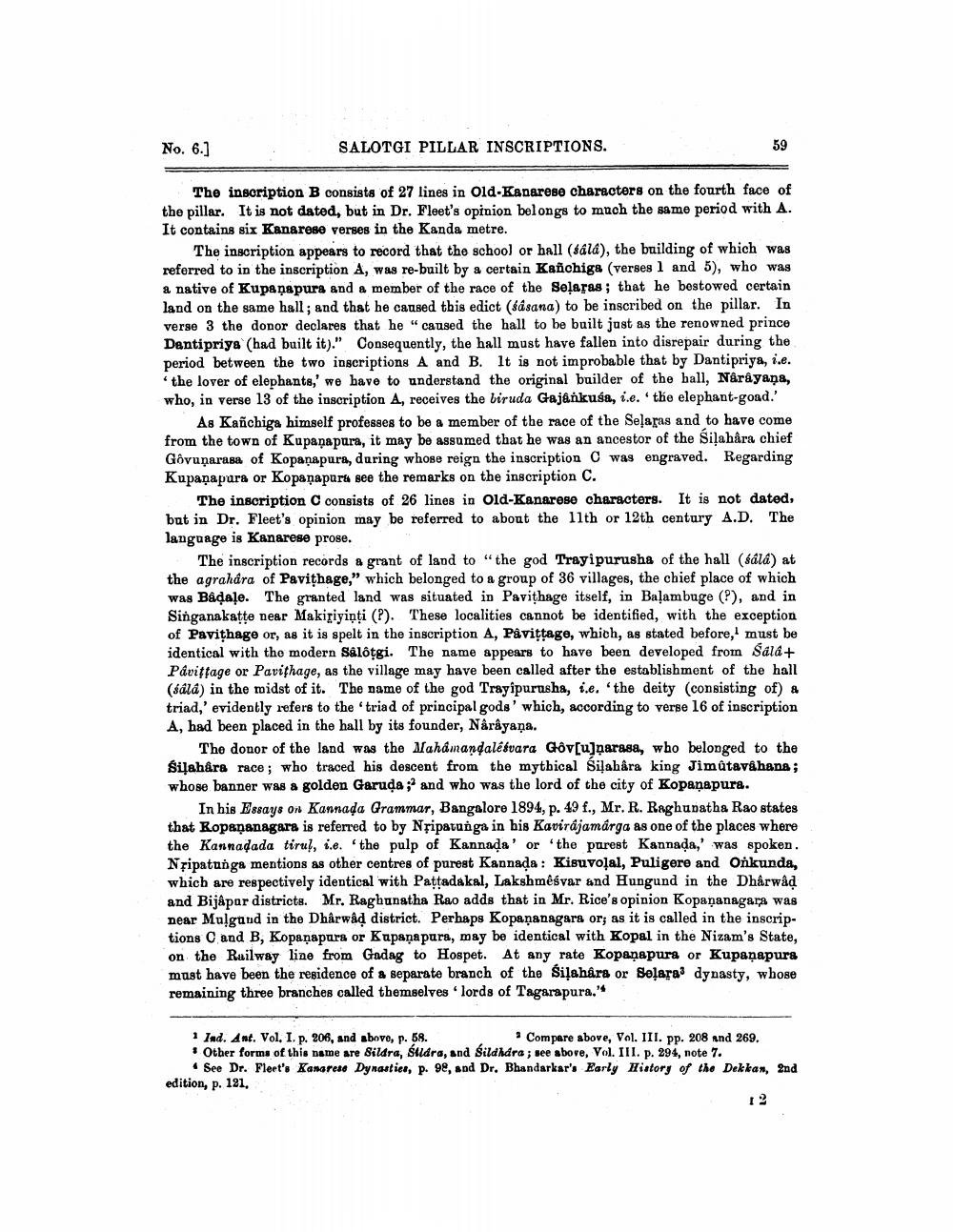________________
No. 6.]
SALOTGI PILLAR INSCRIPTIONS.
The inscription B consists of 27 lines in old-Kanarese characters on the fourth face of the pillar. It is not dated, but in Dr. Fleet's opinion belongs to much the same period with A. It contains six Kanarese verses in the Kanda metre.
The inscription appears to record that the school or hall (sala), the building of which was referred to in the inscription A, was re-built by a certain Kanchiga (verses 1 and 5), who was a native of Kupaņepura and a member of the race of the Selapas; that he bestowed certain land on the same hall; and that he caused this edict (sasana) to be inscribed on the pillar. In verse 3 the donor declares that he caused the hall to be built just as the renowned prince Dentipriya (had built it).". Consequently, the hall must have fallen into disrepair during the period between the two inscriptions A and B. It is not improbable that by Dantipriya, i.e. *the lover of elephants,' we have to understand the original builder of the ball, Narayana, who, in verse 13 of the inscription A, receives the biruda Gajankuģa, i.e. the elephant-goad.'
As Kanchiga himself professes to be a member of the race of the Selaras and to have come from the town of Kupaņapara, it may be assumed that he was an ancestor of the Siļahâra chief Gôvunarasa of Kopanapura, during whose reign the inscription C was engraved. Regarding Kupaņapara or Kopaņapura see the remarks on the inscription C.
The inscription C consists of 26 lines in Old-Kanarese characters. It is not dated, but in Dr. Fleet's opinion may be referred to about the 11th or 12th century A.D. The language is Kanarese prose.
The inscription records a grant of land to "the god Trayipurusha of the hall (sala) at the agrahára of Pavithage," which belonged to a group of 36 villages, the chief place of which was Badaļe. The granted land was situated in Pavithage itself, in Balambuge (?), and in Singanakatte near Makiriyiņți (?). These localities cannot be identified, with the exception of Pavithage or, as it is spelt in the inscription A, Påvittage, which, as stated before, must be identical with the modern Salotgi. The name appears to have been developed from Sala + Pávitfage or Pavithage, as the village may have been called after the establishment of the hall (sala) in the midst of it. The name of the god Trayipurusha, i.e. 'the deity (consisting of) a triad,' evidently refers to the triad of principal gods' which, according to verse 16 of inscription A, had been placed in the hall by its founder, Narayana.
The donor of the land was the Mahamandalesvara Gôv[u]ņarasa, who belonged to the silahárs race; who traced his descent from the mythical Silahâra king Jimûtavahana; whose banner was a golden Garuda ; and who was the lord of the city of Kopaņapura.
In his Essays on Kannada Grammar, Bangalore 1894, p. 49 f., Mr. R. Raghunatha Rao states that Kopananagara is referred to by Nřipatunga in bis Kavirajamárga as one of the places where the Kannadada tirul, i.e. the pulp of Kannada' or the purest Kannada,' was spoken. Nřipatunga mentions as other centres of purest Kannada: Kisuvoļal, Puligere and Onkunda, which are respectively identical with Pattadakal, Lakshmêsvar and Hungund in the Dharwad and Bijâpar districts. Mr. Raghunatha Rao adds that in Mr. Rice's opinion Kopananagara was Dear Mulgaud in the Dharwad district. Perhaps Kopananagara or; as it is called in the inscriptions C and B, Kopanapura or Kapanapura, may be identical with Kopal in the Nizam's State, on the Railway line from Gadag to Hospet. At any rate Kopanapura or Kupaņapura must have been the residence of a separate branch of the Siļahârs or Selara3 dynasty, whose remaining three branches called themselves lords of Tagarapura."
1 Ind. Ant. Vol. I. p. 206, and above, p. 58.
Compare above, Vol. III. pp. 208 and 269. • Other forms of this name are Sildra, sudra, and Sildhára ; see above, Vol. III. p. 294, note 7.
• See Dr. Fleet's Kanarese Dynasties, p. 98, and Dr. Bhandarkar's Early History of the Dekkan, and edition, p. 121.
1 ?




